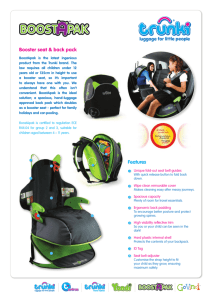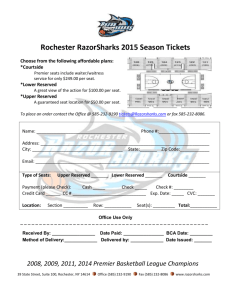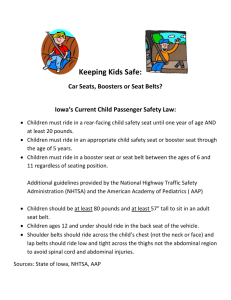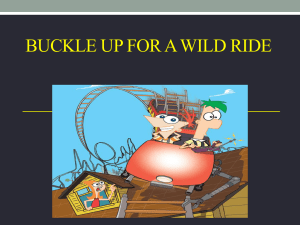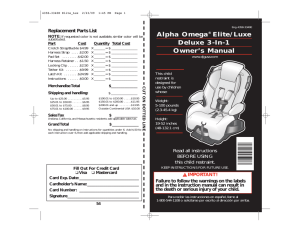Enforcing California Restraint Laws for Children
advertisement
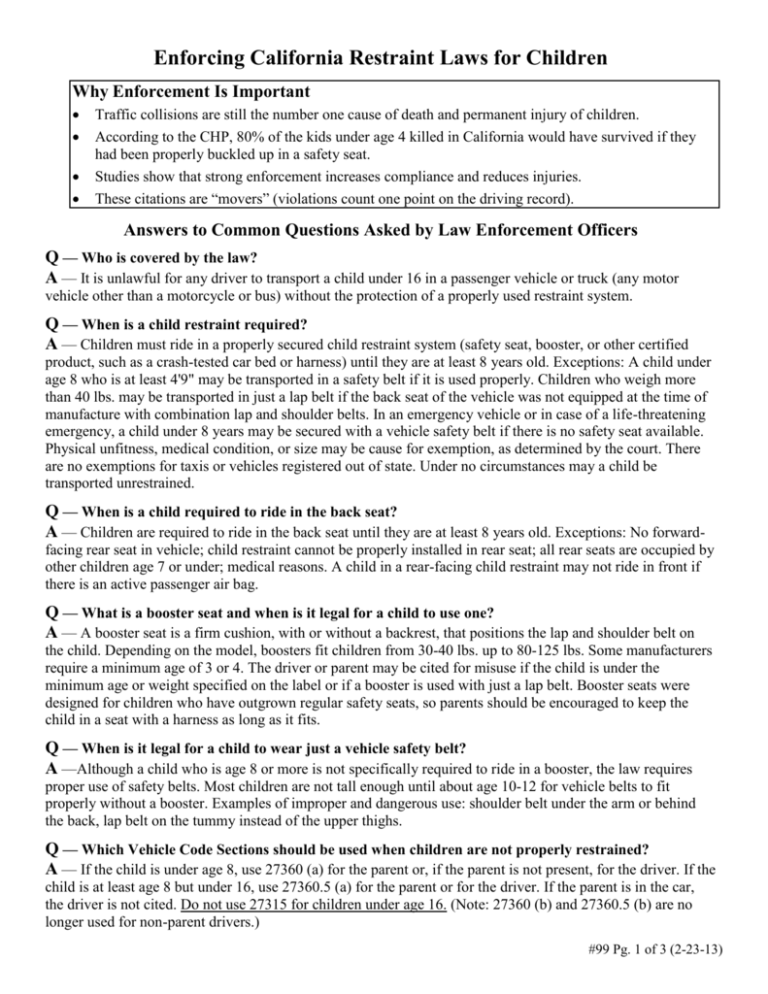
Enforcing California Restraint Laws for Children Why Enforcement Is Important Traffic collisions are still the number one cause of death and permanent injury of children. According to the CHP, 80% of the kids under age 4 killed in California would have survived if they had been properly buckled up in a safety seat. Studies show that strong enforcement increases compliance and reduces injuries. These citations are “movers” (violations count one point on the driving record). Answers to Common Questions Asked by Law Enforcement Officers Q — Who is covered by the law? A — It is unlawful for any driver to transport a child under 16 in a passenger vehicle or truck (any motor vehicle other than a motorcycle or bus) without the protection of a properly used restraint system. Q — When is a child restraint required? A — Children must ride in a properly secured child restraint system (safety seat, booster, or other certified product, such as a crash-tested car bed or harness) until they are at least 8 years old. Exceptions: A child under age 8 who is at least 4'9" may be transported in a safety belt if it is used properly. Children who weigh more than 40 lbs. may be transported in just a lap belt if the back seat of the vehicle was not equipped at the time of manufacture with combination lap and shoulder belts. In an emergency vehicle or in case of a life-threatening emergency, a child under 8 years may be secured with a vehicle safety belt if there is no safety seat available. Physical unfitness, medical condition, or size may be cause for exemption, as determined by the court. There are no exemptions for taxis or vehicles registered out of state. Under no circumstances may a child be transported unrestrained. Q — When is a child required to ride in the back seat? A — Children are required to ride in the back seat until they are at least 8 years old. Exceptions: No forwardfacing rear seat in vehicle; child restraint cannot be properly installed in rear seat; all rear seats are occupied by other children age 7 or under; medical reasons. A child in a rear-facing child restraint may not ride in front if there is an active passenger air bag. Q — What is a booster seat and when is it legal for a child to use one? A — A booster seat is a firm cushion, with or without a backrest, that positions the lap and shoulder belt on the child. Depending on the model, boosters fit children from 30-40 lbs. up to 80-125 lbs. Some manufacturers require a minimum age of 3 or 4. The driver or parent may be cited for misuse if the child is under the minimum age or weight specified on the label or if a booster is used with just a lap belt. Booster seats were designed for children who have outgrown regular safety seats, so parents should be encouraged to keep the child in a seat with a harness as long as it fits. Q — When is it legal for a child to wear just a vehicle safety belt? A —Although a child who is age 8 or more is not specifically required to ride in a booster, the law requires proper use of safety belts. Most children are not tall enough until about age 10-12 for vehicle belts to fit properly without a booster. Examples of improper and dangerous use: shoulder belt under the arm or behind the back, lap belt on the tummy instead of the upper thighs. Q — Which Vehicle Code Sections should be used when children are not properly restrained? A — If the child is under age 8, use 27360 (a) for the parent or, if the parent is not present, for the driver. If the child is at least age 8 but under 16, use 27360.5 (a) for the parent or for the driver. If the parent is in the car, the driver is not cited. Do not use 27315 for children under age 16. (Note: 27360 (b) and 27360.5 (b) are no longer used for non-parent drivers.) #99 Pg. 1 of 3 (2-23-13) Q — V.C. Sections 27360 specifies that child restraints must be used “properly.” How is proper use defined? A — Proper use is defined by the vehicle owner’s manual and child restraint manufacturer instruction booklet. Here are some examples of visible, improper use which are prohibited by all manufacturers. A citation or warning may be issued for these dangerous practices: √ Child riding unrestrained or sharing belt √ Child under age 8 riding in front seat √ Infant facing front of car √ Rear-facing child in front of active air bag √ Harness loose or not on shoulders √ Safety seat loose (can be pulled more than 1”) √ Shoulder belt under arm or behind back Q — How can an officer who has no specialized training in child passenger safety determine if there is a violation? A — Concentrate on the obvious, easily seen violations, such as kids in the front seat, toddlers standing up and moving around, or children riding in the cargo area of a vehicle. These situations are not only easy to spot, but also extremely dangerous for the children. Q — Is it legal to ride in the back of a pickup under a camper shell? What about extra passengers in a vehicle when all of the belts are already in use? A — No. All occupants must be properly restrained (no restraints that meet federal standards are available for the cargo area of a truck). The driver may be cited for violating the child restraint law and/or safety belt law, depending on the age of the unrestrained occupants. Q — How much is the fine? May it be waived? A — The fine for violating V.C. Section 27360 or 27360.5 is $100 plus penalty assessments, which adds up to more than $500. A first offense under this section may be reduced or waived by the court if the defendant shows economic disadvantage. If the fine is reduced, the court is mandated to require the violator to attend an education program. The fine for a second or subsequent offense is $250 plus penalty assessments. Q — What can parents do if they believe they cannot afford to buy a safety seat? A — Most California counties have programs to help people obtain inexpensive safety seats, and officers can provide the number of a local group that might help. The fine money collected for child restraint violations goes to local health departments to help them provide community education and safety seats for low-income families. A safety seat costs about as much as one tank of gas and much less than a baby crib or a playpen. Whether a child comes from an affluent family or a poor one, he or she deserves to be protected from preventable death and injury. Other laws and information about kids and cars Health and Safety Code 118948(a) Smoking restriction Smoking in a vehicle is prohibited if a child under 18 is present. Consequences: The fine is $100 plus penalty assessments V.C. 15620 (a) Unattended Children in Vehicles No person may leave a child age 6 or younger in a vehicle if the health or safety of the child is at risk, the engine is running, or the keys are in the ignition. The child must be supervised by a person at least age 12. Insurance Code 11580.011 Replacing Child Restraints Used in a Crash Auto insurance companies are required to ask whether a child restraint was in the vehicle in a covered crash. If a child was in the restraint or if it was damaged, they must replace it or reimburse for its replacement. After it is replaced, the insured may surrender the child restraint to the nearest office of the California Highway Patrol. #99 Pg. 2 of 3 (2-23-13) DUI and Child Passengers Motor-vehicle-related injury is the leading cause of death for children and young adults aged 1 to 34 years in the United States. Approximately 24% of child traffic deaths involve alcohol. Two-thirds of drinking-driverrelated child passenger deaths in the United States involve a child riding unrestrained in the same vehicle with a drinking driver. For all child passenger deaths, child passenger restraint use decreased as both the child’s age and the blood alcohol concentration of the child’s driver increased.* Be sure to include in your reports details about children, including restraint use, in the car with DUI driver. Consider encouraging filing of child endangerment charges. Guidelines for Best Practice Note: Check manufacturers’ instructions and labels to determine age, weight, and height limits. Recommendation Reason Keep baby facing rear of car as long as possible Young children are 5 times safer in a crash if they are (recommended until at least age 2). riding rear facing. Keep child in seat with harness as long as possible (at 5-point harness is most protective. In a booster, least until age 3 or 4). Choose a seat with a harness that younger children may fall asleep or wiggle out of fits up to 65 lbs. or more. position so the shoulder belt is not on the body. Keep older child in booster seat until lap and shoulder Using a booster reduces injuries about 45% for children belts fit properly. To find out if the child is ready to who do not fit properly in a belt. wear just a safety belt, try the 5-Step Test. Keep all children in the back seat (required until 8). Riding in the back seat is 40% safer. Four Types of Safety Seats Rear-facing-only safety seat Fits until baby reaches maximum weight (30-35 lbs. for most seats; check instructions). Head must be at least 1” below top edge. Must be installed facing rearward. Convertible safety seat Fits up to 35 lbs. or more rear facing, 40 lbs. or more forward facing. Rear facing is strongly recommended until at least age 2. Forward-facing safety seat or harness only Check instructions for minimum age/weight. Most forward-facing seats have a removable harness so they can be used as boosters. Safety booster seat For children who outgrow safety seats with a harness. Most children need a booster until age 10-12 for proper belt fit. Backless booster may be used if child's head is supported by vehicle seat or headrest. *Journal of the American Medical Association, May 3, 2000—Vol 283, No. 17 SafetyBeltSafe U.S.A. P.O. Box 553, Altadena, CA 91003 (310) 222-6860 www.carseat.org #99 Pg. 3 of 3 (2-23-13)
